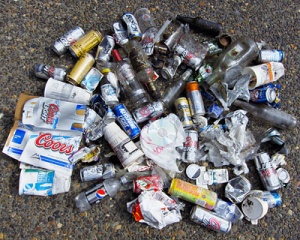If that were all it were, I would probably be OK with it. However, I do have a problem with it, not with bourbons, scotches or beers, mind you, but with trash, pounds and pounds of trash.  A couple of times a week, we have to walk our 800 feet of road frontage and pick up trash. A couple of times a year, our neighbors have to join together to do a much larger clean up. Seriously, in this day and age, littering is still a problem?
A couple of times a week, we have to walk our 800 feet of road frontage and pick up trash. A couple of times a year, our neighbors have to join together to do a much larger clean up. Seriously, in this day and age, littering is still a problem?
The trash we pick up ranges from the Big Gulp Styrofoam cups, McDonald’s sacks, every imaginable brand of soft drink cans, to an unfathomable number of beer cans, beer bottles, vodka bottles, whiskey bottles, etc. etc. etc. For the record, these alcohol bottles are empty and thrown from cars…and we have an open container law? There is even one guy that must have a serious problem because we find an empty pint bottle of Jim Beam every Monday. I even sat behind a red pickup the other day, when the driver opened the window of his cab, stuffed a bag of McDonald’s trash out of it and threw it, not into the bed of his truck, but right on the side of the road. My honk, only drew a one fingered salute. Seriously?
We live in one of the most picturesque parts of our city. A few minutes east of one the largest shopping malls and one of the busiest intersections in the state, you descend into beautiful wooded valley. Trees overhang the road on both sides, a creek meanders through meadows and yards. It is quiet (except for the speeders who think it is a drag race, but that is ANOTHER post), it feels as if you are out in the country, not a part of a major metropolitan area.
[youtube http://www.youtube.com/watch?v=m4ozVMxzNAA&w=420&h=315]
There are only a few houses in this area, so most of the cars are “passing through” on their way to one of the most affluent suburbs in the region. When I drive through those areas, I do not see roadside trash scattered on their manicured lawns, it seems as if, they have decided to literally trash our road instead of their own. Where do they think that trash goes? Who do they think cleans it up? (btw, some ends up in our rivers and streams see my previous post A Dishwasher, two hot water heaters, and a hide-a-bed ) Do they not care what it looks like to drive by miles of soft drink cups? Seriously?
I fantasize about tracking some of the litterers down and dumping their trash onto their lawn, but that would make me no better then them. I have thought about collecting the trash and building a monument for all to see, but then I would just have to look at it (and people would probably litter more). Seriously?
I really can’t think of a solution for ignorance. I can’t think of a way to make people care. Until then, we will continue to pick up after them and pray they don’t wrap their car around one of our trees. Seriously!
If anything you read here or in other posts strikes a chord, I would love to hear from you. Leave a comment, hit me up on Twitter (@jtongici), find me on LinkedIn, or Google +.

 I could go on and on…but what I really wanted to do was to thank the 14 people that gave up 5 or 6 hours of a gorgeous September Saturday morning to provide the muscle needed to accomplish this daunting task! Our 11 canoeists were ably supported by a land crew of three that helped shuttle us along the route and made sure lunch was ready when we were finished. The 11 members of the water crew weere in six canoes (thanks Alan for volunteering to go solo!) and had a fantastic barge provided by the City of Noblesville. Within the first quarter mile we had amassed so much stuff, we had to offload the barge and a couple of canoes at the 206th bridge, where a group of boy scouts helped to move it to the dumpsters.
I could go on and on…but what I really wanted to do was to thank the 14 people that gave up 5 or 6 hours of a gorgeous September Saturday morning to provide the muscle needed to accomplish this daunting task! Our 11 canoeists were ably supported by a land crew of three that helped shuttle us along the route and made sure lunch was ready when we were finished. The 11 members of the water crew weere in six canoes (thanks Alan for volunteering to go solo!) and had a fantastic barge provided by the City of Noblesville. Within the first quarter mile we had amassed so much stuff, we had to offload the barge and a couple of canoes at the 206th bridge, where a group of boy scouts helped to move it to the dumpsters.



